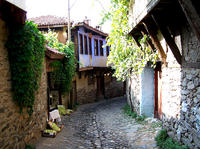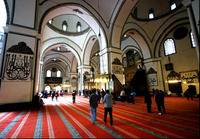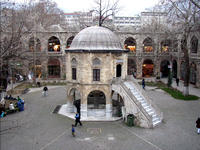You are in: Asia -> Turkey -> Bursa and Cumalıkı... , and traditional search or Image Gallery will yield results of this site only
Bursa and Cumalıkızık: the Birth of the Ottoman Empire
| Site number: | 1452 |
|
| Type of site: | Cultural | |
| Date: | 14th century | |
| Date of Inscription: | 2014 | |
| Location: | Eurasia, Turkey, Bursa, Cumalıkızık | |
Up to 75 images are shown here. Click on each for more details or on Image Gallery for more images.
Six official UN languages:
Arabic,
Chinese,
English,
French,
Russian,
Spanish
Other languages: Afrikaans, Belarusian, Catalan, Croatian, Danish, Georgian, Greek, Hebrew, Italian, Japanese, Kiswahili, Kurdistan, Latvian, Magyar, Norwegian-nynorsk, Portuguese, Slovenian, Thai, Turkish, Urdu, Vietnamese
Other languages: Afrikaans, Belarusian, Catalan, Croatian, Danish, Georgian, Greek, Hebrew, Italian, Japanese, Kiswahili, Kurdistan, Latvian, Magyar, Norwegian-nynorsk, Portuguese, Slovenian, Thai, Turkish, Urdu, Vietnamese
| Description: | This property is a serial nomination of eight component sites in the City of Bursa and the nearby village of Cumalıkızık, in the southern Marmara region. The site illustrates the creation of an urban and rural system establishing the Ottoman Empire in the early 14th century. The property embodies the key functions of the social and economic organization of the new capital which evolved around a civic centre. These include commercial districts of khans, kulliyes (religious institutions) integrating mosques, religious schools, public baths and a kitchen for the poor, as well as the tomb of Orhan Ghazi, founder of the Ottoman dynasty. One component outside the historic centre of Bursa is the village of Cumalıkızık, the only rural village of this system to show the provision of hinterland support for the capital. --WHMNet paraphrase from the description at WHC Site, | |
| Bursa (Turkish pronunciation: [ˈbuɾsa]) is a large city in Turkey, located in northwestern Anatolia, within the Marmara Region. It is the fourth most populous city in Turkey and one of the most industrialized metropolitan centers in the country. The city is also the administrative center of Bursa Province.Cumalıkızık is a village in the Yıldırım district of Bursa Province, located 10 kilometers east of the city of Bursa, at the foot of Mount Uludağ. Its history goes back to the Ottoman Empire's foundation period. The village is now included within the border of the Yıldırım district as a neighbourhood. Cumalıkızık was founded as a vakıf village. The historical texture of the village has been well protected and the civilian countryside architectural structures of the early Ottoman period are still intact. Because of this, Cumalıkızık has become a popular but still unspoiled center for tourists. Bursa was the first capital of the Ottoman State between 1335 and 1413. The city was referred to as Hüdavendigar (meaning "God's gift") during the Ottoman period, while a more recent nickname is Yeşil Bursa (meaning "Green Bursa") in reference to the parks and gardens located across its urban fabric, as well as to the vast and richly varied forests of the surrounding region. The ski resort of Mount Uludağ towers over it. The mountain was called the Mysian Olympus by the Romans who lived there before. Bursa has rather orderly urban growth and borders a fertile plain. The mausoleums of the early Ottoman sultans are located in Bursa and the city's main landmarks include numerous edifices built throughout the Ottoman period. Bursa also has thermal baths and several museums, including a museum of archaeology. --Wikipedia. Text is available under the Creative Commons Attribution-ShareAlike License. | ||
| Source: | http://whc.unesco.org/en/list/1452 | |
| Source2: | Wikipedia (http://wikipedia.com) | |
| Reference: | 1. UNESCO World Heritage Center (http://whc.unesco.org/en/list/1452). 2. Wikipedia. | |
















